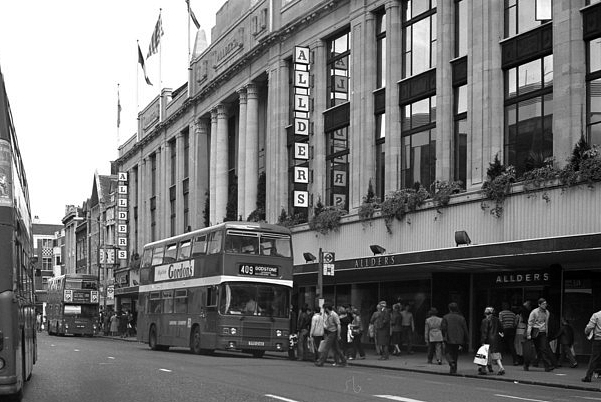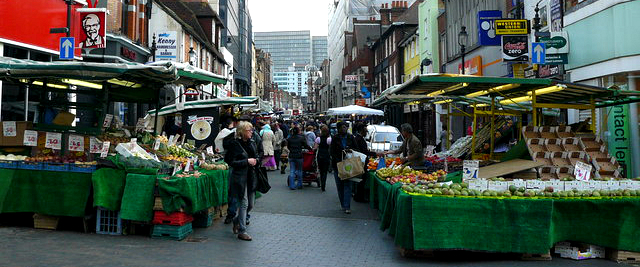|
George Street Tram Stop
George Street tram stop is a tram stop in Croydon, south London, served by Tramlink. It is one of the busiest stops on the line as it is the most centrally located stop for the main shopping areas. It is almost directly outside the former Allders Allders was an independent department store operating in the United Kingdom. The original store was established in 1862 in Croydon by Joshua Allder. In the second half of the 20th century, this parent store was developed into a chain of depart ... store and is on the site of the Park Place proposed development. At this stop, trams only depart in a westbound direction. References Tramlink stops in the London Borough of Croydon Railway stations in Great Britain opened in 2000 {{UK-tram-stub ... [...More Info...] [...Related Items...] OR: [Wikipedia] [Google] [Baidu] |
Tramlink
London Trams, previously Tramlink and Croydon Tramlink, is a light rail tram system serving Croydon and surrounding areas in South London, England. It began operation in 2000, the first tram system in the London region since 1952. It is managed by London Trams, a public body part of Transport for London (TfL), and has been operated by FirstGroup since 2017. Tramlink is one of two light rail networks in Greater London, the other being the Docklands Light Railway. The network consists of 39 stops along of track, on a mixture of street track shared with other traffic, dedicated track in public roads, and off-street track consisting of new rights-of-way, former railway lines, and one right-of-way where the Tramlink track runs parallel to a third rail-electrified Network Rail line. The network's lines coincide in central Croydon, with eastern termini at Beckenham Junction, Elmers End and New Addington, and a western terminus at Wimbledon, where there is an interchange for London ... [...More Info...] [...Related Items...] OR: [Wikipedia] [Google] [Baidu] |
London Borough Of Croydon
The London Borough of Croydon () is a London borough in south London, part of Outer London. It covers an area of . It is the southernmost borough of London. At its centre is the historic town of Croydon from which the borough takes its name; while other urban centres include Coulsdon, Purley, South Norwood, Norbury, New Addington and Thornton Heath. Croydon is mentioned in Domesday Book, and from a small market town has expanded into one of the most populous areas on the fringe of London. The borough is now one of London's leading business, financial and cultural centres, and its influence in entertainment and the arts contribute to its status as a major metropolitan centre. Its population is 386,710, making it the second largest London borough and fifteenth largest English district. The borough was formed in 1965 from the merger of the County Borough of Croydon with Coulsdon and Purley Urban District, both of which had been within Surrey. The local authority, Croydon Londo ... [...More Info...] [...Related Items...] OR: [Wikipedia] [Google] [Baidu] |
London Fare Zones
Rail service fares in Greater London and the surrounding area are calculated in accordance with the London fare zones system managed by Transport for London. Within London, all London Underground, National Rail, London Overground, TfL Rail and Docklands Light Railway stations are assigned to six fare zones.Stations can be assigned to one or two fare zones Fare zone 1 covers the central area and fare zones 2, 3, 4, 5 and 6 form concentric rings around it. Some National Rail stations and almost all Transport for London served stations outside Greater London in the home counties of Buckinghamshire, Essex, Hertfordshire and Surrey are either included in fare zones 4, 5 or 6 or in extended zones beyond these. Transport for London fare zones are also known simply as zones or travelcard zones, referring to their use in calculating prices for the travelcards or pay-as-you-go caps. Before flat fares were introduced in 2004, fare zones were used on the London Buses network. London fare zo ... [...More Info...] [...Related Items...] OR: [Wikipedia] [Google] [Baidu] |
Tram
A tram (called a streetcar or trolley in North America) is a rail vehicle that travels on tramway tracks on public urban streets; some include segments on segregated right-of-way. The tramlines or networks operated as public transport are called tramways or simply trams/streetcars. Many recently built tramways use the contemporary term light rail. The vehicles are called streetcars or trolleys (not to be confused with trolleybus) in North America and trams or tramcars elsewhere. The first two terms are often used interchangeably in the United States, with ''trolley'' being the preferred term in the eastern US and ''streetcar'' in the western US. ''Streetcar'' or ''tramway'' are preferred in Canada. In parts of the United States, internally powered buses made to resemble a streetcar are often referred to as "trolleys". To avoid further confusion with trolley buses, the American Public Transportation Association (APTA) refers to them as "trolley-replica buses". In the Unit ... [...More Info...] [...Related Items...] OR: [Wikipedia] [Google] [Baidu] |
Croydon
Croydon is a large town in south London, England, south of Charing Cross. Part of the London Borough of Croydon, a local government district of Greater London. It is one of the largest commercial districts in Greater London, with an extensive shopping district and night-time economy. The entire town had a population of 192,064 as of 2011, whilst the wider borough had a population of 384,837. Historically an ancient parish in the Wallington hundred of Surrey, at the time of the Norman conquest of England Croydon had a church, a mill, and around 365 inhabitants, as recorded in the Domesday Book of 1086. Croydon expanded in the Middle Ages as a market town and a centre for charcoal production, leather tanning and brewing. The Surrey Iron Railway from Croydon to Wandsworth opened in 1803 and was an early public railway. Later 19th century railway building facilitated Croydon's growth as a commuter town for London. By the early 20th century, Croydon was an important industria ... [...More Info...] [...Related Items...] OR: [Wikipedia] [Google] [Baidu] |
London
London is the capital and largest city of England and the United Kingdom, with a population of just under 9 million. It stands on the River Thames in south-east England at the head of a estuary down to the North Sea, and has been a major settlement for two millennia. The City of London, its ancient core and financial centre, was founded by the Romans as '' Londinium'' and retains its medieval boundaries.See also: Independent city § National capitals The City of Westminster, to the west of the City of London, has for centuries hosted the national government and parliament. Since the 19th century, the name "London" has also referred to the metropolis around this core, historically split between the counties of Middlesex, Essex, Surrey, Kent, and Hertfordshire, which largely comprises Greater London, governed by the Greater London Authority.The Greater London Authority consists of the Mayor of London and the London Assembly. The London Mayor is distinguished fr ... [...More Info...] [...Related Items...] OR: [Wikipedia] [Google] [Baidu] |
Allders
Allders was an independent department store operating in the United Kingdom. The original store was established in 1862 in Croydon by Joshua Allder. In the second half of the 20th century, this parent store was developed into a chain of department stores across England and Wales. By the turn of the millennium, the flagship store in Croydon was the third-largest department store in the United Kingdom. The chain was broken up and sold after it went into administration in 2005, although the Croydon store continued trading until 2012, having been purchased by Harold Tillman, the then-owner of the Jaeger clothing company. On 17 January 2013, the company closed the store along with the website, and the brand ceased to exist. In 2018 the brand relaunched with a department store in the former Co-op Department Store in the Paisley Centre in Paisley. Joshua Allder Allders was opened in 1862 at 102 and 103 North End, Croydon, as a "linen draper and silk mercer" by Joshua Allder (1838–1 ... [...More Info...] [...Related Items...] OR: [Wikipedia] [Google] [Baidu] |
Park Place (Croydon)
Park Place was a proposed shopping centre which had been expected to open in Croydon, London by 2011. The date was continuously pushed back due to a number of problems between different developers, financial backers and the local council.''Croydon Guardian''Work on Park Place delayed 7 May 2008. It was cancelled in 2009, as other schemes began progress, such as the extension to Centrale and the possible takeover of the Whitgift Centre by Westfield Group. Park Place was part of the Croydon Vision 2020 re-generation scheme. Park Place has been proposed by developers Minerva plc and was given planning approval in 2000 by Croydon Council after which the Government Office for London decided not to proceed with a call-in in 2003, despite concerns over traffic and the impact upon existing retail. This decision, ultimately by Deputy Prime Minister John Prescott, caused controversy in 2006 amidst the Cash for Peerages political scandal, when it emerged that two of Minerva's previous an ... [...More Info...] [...Related Items...] OR: [Wikipedia] [Google] [Baidu] |
Croydon Tramlink 2000
Croydon is a large town in south London, England, south of Charing Cross. Part of the London Borough of Croydon, a local government district of Greater London. It is one of the largest commercial districts in Greater London, with an extensive shopping district and night-time economy. The entire town had a population of 192,064 as of 2011, whilst the wider borough had a population of 384,837. Historically an ancient parish in the Wallington hundred of Surrey, at the time of the Norman conquest of England Croydon had a church, a mill, and around 365 inhabitants, as recorded in the Domesday Book of 1086. Croydon expanded in the Middle Ages as a market town and a centre for charcoal production, leather tanning and brewing. The Surrey Iron Railway from Croydon to Wandsworth opened in 1803 and was an early public railway. Later 19th century railway building facilitated Croydon's growth as a commuter town for London. By the early 20th century, Croydon was an important industr ... [...More Info...] [...Related Items...] OR: [Wikipedia] [Google] [Baidu] |





